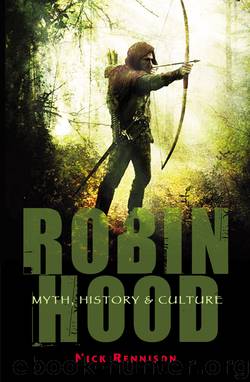1842432478 (N) by Nick Rennison

Author:Nick Rennison [Rennison, Nick]
Language: eng
Format: epub, azw3, mobi
ISBN: 9781842436370
Publisher: Pocket Essentials
Published: 2012-02-12T22:00:00+00:00
Illustrated Robin
Most people have their own image of Robin Hood but there are certain elements which are common to nearly all the pictures of the iconic outlaw that individuals carry in their heads. He is a handsome, athletic figure dressed in Lincoln green or, occasionally, in red. He wears a green peaked hat, usually with a feather in it, and he carries a longbow and a quiver full of arrows on his shoulder. He is usually bearded or has a moustache. This is an image that has survived many deliberate attempts to reinvent it in recent film and TV presentations of the character and it is tempting to assume that it dates back hundreds of years. In fact, it is a relatively recent creation, an amalgam of late nineteenth-century illustrations and the images on screen in the Fairbanks and Flynn films. Throughout most of his career, nobody knew what the famous outlaw looked like nor, it seems, did they much care.
For many centuries, visual representation of Robin is either very difficult to find or so blandly generic that it lacks any real interest. It was only in the late eighteenth century that the first artist of any merit turned his attention to the outlaw and it was only in the middle decades of the following century that a tradition of depicting him was first established. Perhaps the first surviving image intended to represent Robin Hood can be found in St. Mary’s Church in Beverley in the East Riding of Yorkshire. A wooden carving on a misericord which dates from c. 1450 shows two figures which scholars believe are meant to be Robin and the king standing amongst some trees. (In the other great medieval church in the town, Beverley Minster, a small stone sculpture from the previous century depicts a man with a longbow who might just conceivably be Robin but seems much more likely to be an unspecific archer.) Move forward a hundred years and a stained glass window now in the Victoria and Albert Museum, which probably dates to the middle of the sixteenth century, shows figures from the May Games. Maid Marian and Friar Tuck are clearly recognisable and some people have claimed one of the others as Robin but the identification seems, at the very least, debatable.
In the ballads, broadsides and chapbooks that proliferated over the next two centuries, Robin was often illustrated but the woodcuts that were used were common images. They were not intended to be accurate portraits of him and his associates and they were often recycled from other texts. Indeed, many of them made no gesture at all towards medievalism. In the same way that Romans on the stage in Shakespeare’s day dressed like ordinary Elizabethans, Robin and his merry men were most often depicted in clothes that were contemporary with the period in which the woodcuts were printed. Ruffs, long gowns and shovel hats were in evidence rather than medieval costume. Or medieval hoods.
Visual representation of Robin began to change and become more specific in the second half of the eighteenth century.
Download
1842432478 (N) by Nick Rennison.azw3
1842432478 (N) by Nick Rennison.mobi
This site does not store any files on its server. We only index and link to content provided by other sites. Please contact the content providers to delete copyright contents if any and email us, we'll remove relevant links or contents immediately.
| Diaries & Journals | Essays |
| Letters | Speeches |
The Rules Do Not Apply by Ariel Levy(3928)
Bluets by Maggie Nelson(3738)
Too Much and Not the Mood by Durga Chew-Bose(3707)
Pre-Suasion: A Revolutionary Way to Influence and Persuade by Robert Cialdini(3437)
The Motorcycle Diaries by Ernesto Che Guevara(3358)
Walking by Henry David Thoreau(3244)
What If This Were Enough? by Heather Havrilesky(2952)
The Day I Stopped Drinking Milk by Sudha Murty(2871)
Schaum's Quick Guide to Writing Great Short Stories by Margaret Lucke(2818)
The Daily Stoic by Holiday Ryan & Hanselman Stephen(2720)
Why I Write by George Orwell(2374)
Letters From a Stoic by Seneca(2344)
The Social Psychology of Inequality by Unknown(2328)
A Short History of Nearly Everything by Bryson Bill(2148)
Feel Free by Zadie Smith(2118)
Insomniac City by Bill Hayes(2094)
A Burst of Light by Audre Lorde(1987)
Upstream by Mary Oliver(1948)
Miami by Joan Didion(1886)
